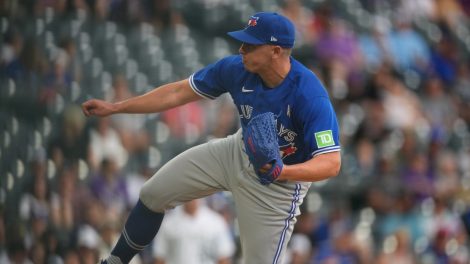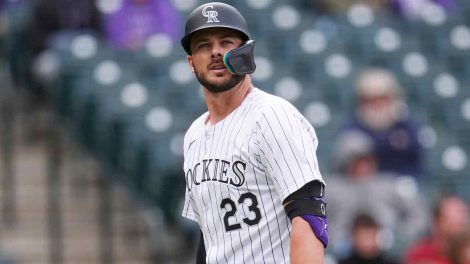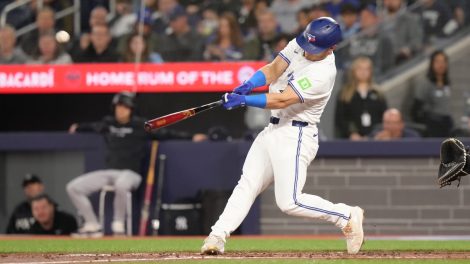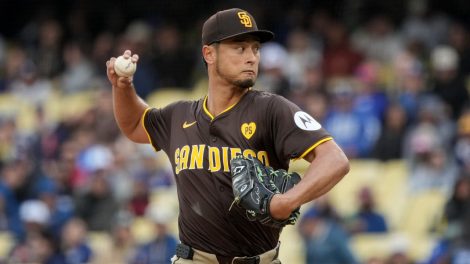It was like a soundtrack to your nightmare if you were an opposing pitcher at Coors Field. A symphony from ERA hell. Ozzy’s “Crazy Train” whenever Larry Walker came to the plate, Peter Gabriel’s “Sledgehammer” whenever Father of Bo walked up with his bat.
Ah, Coors Field. It giveth, if you are a hitter. It taketh away, if you are a pitcher. Today, we’ll know for certain what it does to Walker’s Hall of Fame case. Watching like the rest of us will be his former teammate and father of Toronto Blue Jays shortstop Bo Bichette.
“Those Colorado Rockies teams were close, because none of us were getting any respect,” Dante Bichette said a couple of days ago, just after getting out of the batting cage with son Bo. “We weren’t getting it for our hitting because we played in Coors Field. Our pitchers weren’t getting it for their pitching because we played in Coors Field. That makes you close.”
Early Tuesday evening – afternoon in the Rockies’ and Walker’s hometown of Maple Ridge, B.C. – Hall of Fame voters will render their final verdict on the career of Walker, and decide whether or not Cooperstown has its first Canadian-born position player and first Canadian-born inductee since Chatham, Ont.’s Ferguson Jenkins in 1991.
Although I believe I’m going to come up a little short today I still wanna thank all you that have been pulling for me and showing your support. I’m grateful for all of you! It’s been fun leading up to today reading everyone’s thoughts. Cheers LW
— Larry Walker (@Cdnmooselips33) January 21, 2020
You can have a healthy debate over Walker’s credentials. He passed the eye test as a five-tool player – or, as Bichette called him, “a five-plus-plus tool player” – with a strong throwing arm and enough speed to steal 230 bases while taking the extra base on balls in play far more than average.
Jay Jaffe’s influential JAWS system, which measures a player’s Hall of Fame worthiness, ranks Walker 10th overall among right-fielders, ahead of slam-dunk inductees such as Vladimir Guerrero (who needed just two ballots to be elected with 92.9 per cent support in 2018) and Tony Gwynn (who was elected on the first ballot in 2007 with 97.6 per cent).
Walker is one of 10 players ever to slash .300/.400/.500. Eight of the others are in the Hall and they are among the game’s biggest names of all time. Walker is the only one not in who has never failed a drug test. The other, Manny Ramirez, was twice suspended for PED use.
There are some mitigating factors, of course. By the end of his career, Walker had missed almost a quarter of his team’s scheduled games, including 142 games combined in his last two seasons, a lack of health that his manager with the Montreal Expos, Felipe Alou, predicted early.
Mostly, there’s the Coors Field factor, and for all the park adjustment factors and deep dive sabermetric stuff, the high altitude and thin air of the Rockies’ home ballpark has created a sense in some quarters that the numbers produced there are as phony as the numbers produced by steroids. Walker’s splits between Coors Field and all other parks is extreme, but mostly because the Coors numbers are stratospheric. Things became so outrageous that eventually baseballs were stored in humidors before games at Coors Field. And this was an outrageous time in general for baseball. Steroid use was rampant. Numbers were skewed all over the place.
Such is the double-edged sword that is the legacy of the “Blake Street Bombers,” the nickname given to the Rockies sluggers after the club moved from Mile High Stadium to Coors Field in the team’s third year of existence, 1995. Post-season success was negligible due to a lack of pitching – the Bombers lost 3-1 to the Atlanta Braves in the ’95 NLDS despite having home-field advantage – but, man, what a show.
[snippet id=4722869]
Until Major League Baseball ordered the humidor put in, the Bombers – Walker, Bichette, Vinny Castilla, Andres Galarraga and honourary member Ellis Burks – pounded out 985 homers. It was just silly: in 1996, the Rockies became the first team to hit 200 homers and steal 200 bases in the same season. The year before, Bichette finished second in NL MVP voting after leading the league in hits (197), homers (40) and RBI (126). In 1997, Walker would win the NL MVP award, the first of three consecutive seasons in which he would post an OPS over 1.000.
“Don Baylor (the Rockies’ manager at the time) would put us in the last group during BP because he knew that was when the other team’s pitchers would be out stretching,” said Bichette. “And we’d be putting ball after ball out into the upper deck or into the concourses. We were all professional hitters. We all had our routines just like every other team … we’d go the other way and all that stuff. But then the final few rounds … we’d hit balls where only our group could hit balls.”
It was an eclectic group. Walker joined on a four-year, $22.5-million contract after the Expos didn’t offer him a contract following the 1994 players strike, part of a whirlwind teardown that saw the team trade Ken Hill, Marquis Grissom and John Wetteland in a matter of hours. Bichette was traded to the Rockies at age 29 by the Milwaukee Brewers for Canadian Kevin Reimer; Castilla was the 40th pick in the 1992 expansion draft; Galarraga arrived as a free agent on an $850,000 contract before inking a four-year, $12 million deal.
Back then I was covering the Expos for the Montreal Gazette, and I can remember Alou talking about an upcoming trip to Coors Field a week in advance, worrying about the impact on his pitchers’ psyche and health. Alou had managed in Denver in 1981 while in Montreal’s minor league system and it was his Expos who were the Rockies’ opponents in their first-ever home games as an expansion team in 1993. The teams combined to score 57 runs over a three-game series, with the Rockies winning the final game 19-9. Due to a hamstring strain, Walker was limited to one pinch-hit appearance in that series.
Baseball writers have always loved the quintessential Canadian aspect of Walker’s career – failed junior hockey star becomes his country’s best baseball player ever – but let’s be clear: despite the fact that Walker broke in with the Expos and won a pair of Gold Gloves and made an All-Star appearance with them, the legend blossomed in Denver.
I guess if the narrative was perfect, we’d say that Walker was the good old, modest Canadian hockey player, working away to craft a baseball career and overcoming the limitations placed on him by geography. Except that wasn’t the case. When it came to baseball he was a natural. Tony La Russa managed Walker in his final season with the St. Louis Cardinals and called him one of the most instinctive and naturally gifted players he’d ever managed.
Bichette, who hit 201 of his 217 career home runs in the seven years he played with the Rockies, said: “To me, the basepaths are where you judge instinctive players. I mean, everybody can look ugly at home plate sometimes, you know? Larry was the fastest and smartest and best baserunner I saw. Effortless. The game was just so, so slow for him and he was so quick mentally.”
At the plate, Bichette said that Walker had “the holy grail, the ability to hit for real power to all fields. As a hitter, he had it all. Bat speed. Hand-eye coordination. Instincts. I saw him walk off a game with a bunt. When he was right, I called him a ‘three-fifty’ hitter: 150 RBI, 50 home runs and 50 stolen bases.”
[snippet id=3305549]
Bichette is well aware of how people view the Coors Field effect. He’s comfortable with it. Having Walker in the Hall of Fame might signal an acceptance of the reality that is playing baseball in Colorado – while also paving the way for the likes of Todd Helton and future Rockies hitters.
Look at some of the configurations of ballparks back in the day. Hell, check Ken Griffey Jr.’s numbers in the old Kingdome. Nobody forced Major League Baseball to put a team in Denver. But then, that’s what makes the baseball Hall of Fame the most difficult to enter: no sport has as many mitigating factors.
Beyond impacting the game’s view of statistics, Bichette says not enough attention is paid to the other side of calling Coors Field your home.
“Look: three- or four-hole hitters are going to hit home runs in any park,” said Bichette, who was the Rockies’ hitting coach in 2013. “That’s what they do. If you play for the Rockies, you realize the breaking ball doesn’t break because of the altitude. So, all you see are fastballs.
“That would happen to us. Then, we’d go on the road and now all we’re seeing is breaking balls that we hadn’t seen for a week. That beats you up for a while. You’d go five or six games, start feeling better … then, it was time to go back to Coors where you wouldn’t see another breaking ball.
[relatedlinks]
“And that light air really takes it out of you. We didn’t have all that stuff guys have now, so we just grinded it out. You understand what it does to your body when you leave it.”
From a distance, it appears that Walker’s final bid for the Hall of Fame could go either way. His case certainly wasn’t helped when the Hall of Fame dropped the number of years of ballot eligibility from 15 to 10 in 2014. Now he’ll have to climb from 54.7 per cent support to 75 per cent in a single year – a rarely-seen jump.
And so we wait. Unlike many players who find themselves on the Cooperstown bubble, Walker has avoided pressing his case via social media or by doing a raft of interviews. He has been helped by analytics, but hasn’t really found some person or organization to press his cause. In this way, he has kept very much in character. It’s been a refreshing candidacy, to be honest. In a few hours, we’ll know how successful it’s been – and whether Walker can do for Coors Field what Edgar Martinez did for designated hitters.









